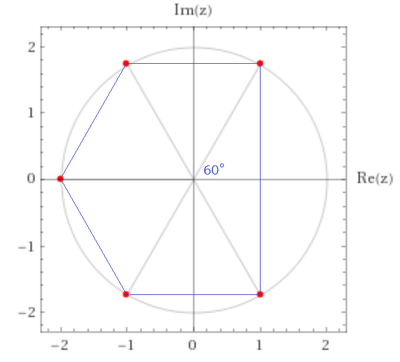Rooty Pentagon
Let f ( z ) = z 5 + 2 z 4 + 4 z 3 + 8 z 2 + 1 6 z + 3 2 , and P 1 , P 2 , . . . , P 5 be points on the complex plane each corresponding to a distinct root of f ( z ) . The area of the pentagon formed by connecting these points may be expressed in the form a 3 for some integer a . What is a ?
The answer is 5.
This section requires Javascript.
You are seeing this because something didn't load right. We suggest you, (a) try
refreshing the page, (b) enabling javascript if it is disabled on your browser and,
finally, (c)
loading the
non-javascript version of this page
. We're sorry about the hassle.
3 solutions
z 5 + 2 z 4 + 4 z 3 + 8 z 2 + 1 6 z + 3 2 ( z + 2 ) ( z 4 + 4 z 2 + 1 6 ) ( z + 2 ) ( z 2 + 2 − 2 3 i ) ( z 2 + 2 + 2 3 i ) ( z + 2 ) ( z + 1 + i 3 ) ( z − 1 − i 3 ) ( z + 1 − i 3 ) ( z − 1 + i 3 ) = 0 = 0 = 0 = 0
⟹ z = ⎩ ⎪ ⎪ ⎪ ⎪ ⎪ ⎪ ⎨ ⎪ ⎪ ⎪ ⎪ ⎪ ⎪ ⎧ 1 + i 3 − 1 + i 3 − 2 − 1 − i 3 − 1 + i 3 = 2 e 3 π i = 2 e 3 2 π i = 2 e π i = 2 e 3 4 π i = 2 e 3 5 π i

Plotting the roots on a complex plane, we note that the area of the pentagon is equal to five equilateral triangles with side length 2 , which is 5 × 2 1 × 2 2 sin 6 0 ∘ = 5 3 , therefore a = 5 .
factorizing the equation we get (x+2)(X^4+4x^2+16)=0 whose roots are -2,2w,-2w,2w^2,-2w^2 , where "w" is the complex cube root of unity. now simply plotting these points in the argand plane and finding the area using basic geometry ..
Note that f ( 2 z ) = 3 2 ( z 5 + z 4 + z 3 + z 2 + z + 1 ) = 3 2 ( z − 1 z 6 − 1 ) whose roots are all 6th roots of unity except z = 1 . Now, if r is a root of f ( 2 z ) , then 2 r is a root of f ( z ) , so the roots of our original polynomial f ( z ) are twice all the roots of f ( 2 z ) , namely 2 e i 6 2 k π for k = 1 , 2 , 3 , 4 , 5 . On the complex plane, this appears as:
The rectangle has width 2 and height 2 3 , and the triangle has base 2 3 and height 1 , so their combined area is: 2 ⋅ 2 3 + 2 1 ⋅ 2 3 ⋅ 1 = 5 3 So a = 5